Are you struggling to pack on muscle? Have you got access to dumbbells? If you answered yes to both, then keep reading! Because today, I will be sharing a hardgainer dumbbell workout to build muscle!
Hardgainers can build muscle using dumbbells by performing a mixture of compound and isolation-type exercises that target all the muscles in the body. This should also be combined with regular progressive overload, a caloric surplus, and a high protein diet.
I use to be a self-proclaimed “hardgainer” myself, so I know your struggles.
But I also managed to gain 40lbs of lean muscle. And I want to share some of the exercises which helped me to do so.
So let’s jump right in!
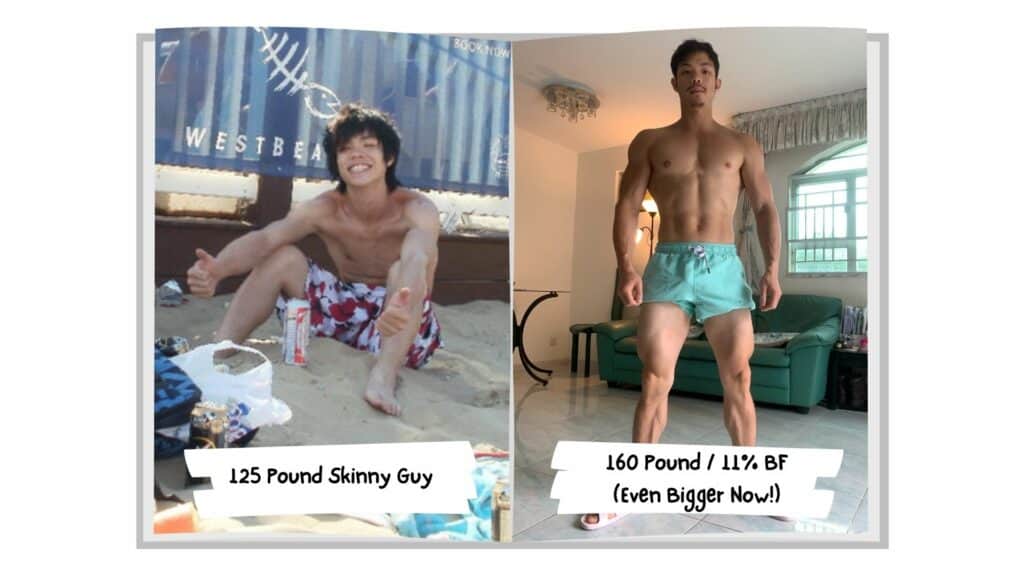
- What You'll Need
- 12 Dumbbell Exercises For A Hardgainer Workout
- 1. Dumbbell Bench Press.
- 2. Dumbbell Chest Fly.
- 3. Standing Dumbbell Shoulder Press.
- 4. Dumbbell Lateral Raise.
- 5. Dumbbell Overhead Tricep Extension.
- 6. Dumbbell Bicep Curl.
- 7. Bent-Over Dumbbell Row.
- 8. Dumbbell-Weighted Pull-Up.
- 9. Dumbbell Crunch.
- 10. Dumbbell Leg Raise.
- 11. Dumbbell Lunge.
- 12. Goblet Squat.
- Example Full-Body Hardgainer Dumbbell Workout.
- Recommended Gear
- Conclusion
What You’ll Need
1) Fully-Adjustable Dumbbells
These should allow you to perform heavy and light lifting to target large and small muscle groups.
Ideally, they should also feature small weight increments to allow you to progressively add a small amount of weight over time. This will promote continued muscle growth.

I use and recommend the Powerblock Elites.
But the Yes4All spinlocks make an awesome budget alternative.
2) Adjustable Weight Bench
A flat/incline/decline bench allows you to hit different regions of your chest, back, and abs with maximum efficiency (think exercises like the incline bench press, incline row, and decline sit-ups).
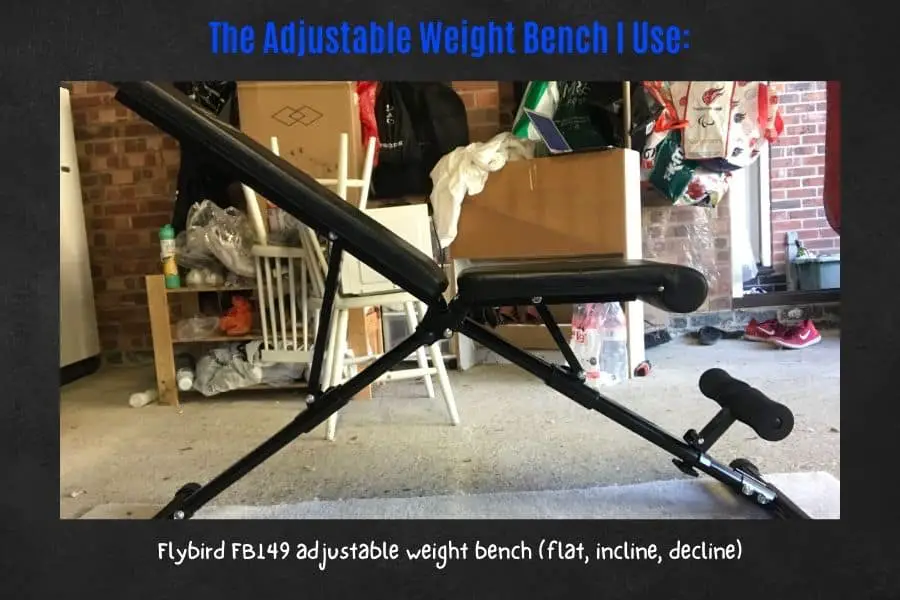
I use and recommend the Flybrd bench.
It’s affordable and works great with the 2 dumbbells mentioned above.
It can also be folded and stowed away after a workout.
3) Power Tower (Optional)
Pull-ups are essential for transforming a skinny back into a broad back.
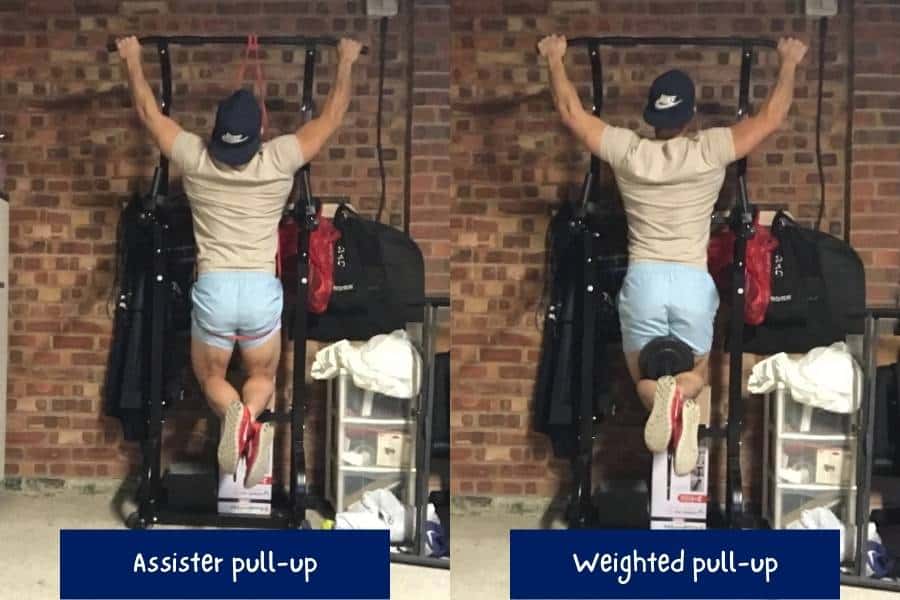
I use and recommend the Sports Royal Tower.
It’s affordable, has a low footprint, and is very stable.
Unlike a doorway pull-up bar, a tower won’t damage your property.
12 Dumbbell Exercises For A Hardgainer Workout
First, here are 12 dumbbell exercises that should be included in every hardgainer’s dumbbell training program:
| Dumbbell Exercise | Exercise Type | Why It’s Great For Hardgainers |
|---|---|---|
| 1. Dumbbell Bench Press | Compound | Add mass and volume to stubborn pecs. |
| 2. Dumbbell Chest Fly | Isolation | Add definition to the cleft in between the pecs. |
| 3. Dumbbell Shoulder Press | Compound | Add mass and volume to stubborn arms and shoulders. |
| 4. Dumbbell Lateral Raise | Isolation | Add mass and definition to the sides of the shoulders. |
| 5. Dumbbell Overhead Tricep Extension | Isolation | Add mass and definition to the triceps. |
| 6. Dumbbell Bicep Curl | Isolation | Add mass and definition to the biceps and forearms. |
| 7. Bent-Over Dumbbell Row | Compound | Add mass and thickness to a stubborn back. |
| 8. Dumbbell Weighted Pull-Up | Compound | Add width and shape to a stubborn back. |
| 9. Dumbbell Crunch | Isolation | Add definition to the abs. |
| 10. Dumbbell Leg Raise | Isolation | Add definition to the lower abs. |
| 11. Dumbbell Lunge | Compound | Add mass to the rear leg. |
| 12. Goblet Squat | Compound | Add mass and volume to stubborn legs. |
Next, I will explain why each exercise will help you to pack on muscle as a hardgainer! These are all exercises I used to gain 40lbs of lean muscle. The exercises have also been verified by coaches and personal trainers!
You can check out my other article to find out if home dumbbells are worth the money!
1. Dumbbell Bench Press.
What I Say:
You can perform the bench press with a barbell or dumbbell. But the dumbbell bench press is perfect for hard gainers to get a good pump on the pectorals.
In support of this, a 2016 study showed that the dumbbell bench press led to 4% higher pectoral activation, compared to the barbell bench press.
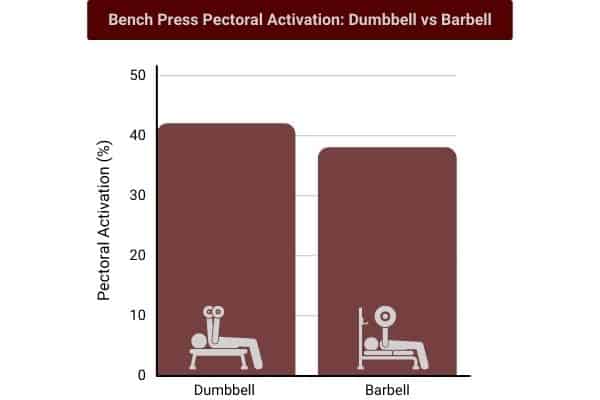
I recommend using a weight that allows you to perform 8 reps per set, for 3 or 4 sets. And progressively overload each week by increasing rep number.
Once you reach 12 reps per set (the threshold before hypertrophy training turns into endurance training), begin to increase weight instead of reps.
You can go to my other post for a weight comparison between the barbell and dumbbell bench press.
What The Expert Says:
Mike Deward (CSCS Coach at Barbend) notes that the dumbbell bench press is “extremely effective” at increasing pec, tricep, and deltoid strength and mass.
He also explains that the greater range of motion in a dumbbell bench press leads to a greater stretch, compared to a barbell bench press. And this increases blood flow to the pecs, which is beneficial for muscle growth.
What You Need:
- Dumbbells.
- Flat weight bench like the Flybird.
The dumbbell bench press is an effective dumbbell exercise for increasing strength and mass in the pectoral, anterior deltoids, and tricep muscles. The greater range of motion provided by dumbbells leads to a greater muscle stretch, compared to the barbell bench press. And this is beneficial for muscular hypertrophy.
You can find out why your chest isn’t growing in my other article!
2. Dumbbell Chest Fly.
What I Say:
The dumbbell chest fly is an awesome dumbbell exercise to isolate the pecs. This can be extremely useful for hardgainers who have yet to master the bench press technique.
When you perform the bench press with sub-par technique, you often unintentionally push with your triceps and anterior deltoids.
As a result, you don’t engage the pecs properly.
Instead, hardgainers can perform dumbbell chest flyes to exclusively work the pecs, whilst working on your bench pressing technique.
If you don’t have a weight bench, you can check out my other article for homemade weight bench alternatives!
What The Experts Say:
Andrew Heffernan (CSCS Coach at Openfit) notes that the chest fly is a great exercise to stretch your pectoral muscle fibers (and thus promote muscle growth).
He also recommends performing chest flyes at END of your chest workout (for example, after your dumbbell bench presses). That way, you can ensure your pecs are worked to their absolute limit.
What You Need:
- Dumbbells
- Flat weight bench.
The dumbbell chest fly is a great exercise to isolate a contraction directly onto your pectoral muscles. This exercise can be combined with the bench press to ensure the chest muscles receive maximal stimulation. And this will ensure growth in the pectoral muscle.
Check out my other article for the pros and cons of dumbbell training!
3. Standing Dumbbell Shoulder Press.
What I Say:
This is a dumbbell exercise I highly recommend hardgainers to perform, and it’s one I wish I did more of in my early lifting days.
The dumbbell shoulder press will mainly help you develop broader shoulders as a hardgainer. More specifically, it activates the anterior, posterior, and lateral deltoids as the primary mover.
But being a compound exercise, it also works the triceps and to some extent, the upper pecs.
As a result, the dumbbell shoulder press helps hardgainers to develop overall upper body pushing strength. And this also benefits other exercises such as the dumbbell bench press.
You can go to my other article to find out the average dumbbell shoulder press weights standards.
What The Experts Say:
Tom Kelso (Coach at Breaking Muscle) points us to a 2013 study to show the effectiveness of the dumbbell shoulder press.
This study demonstrated that performing the standing overhead press using dumbbells resulted in a 15% greater anterior deltoid activation, and 7% greater lateral deltoid activation, compared to the barbell overhead press.
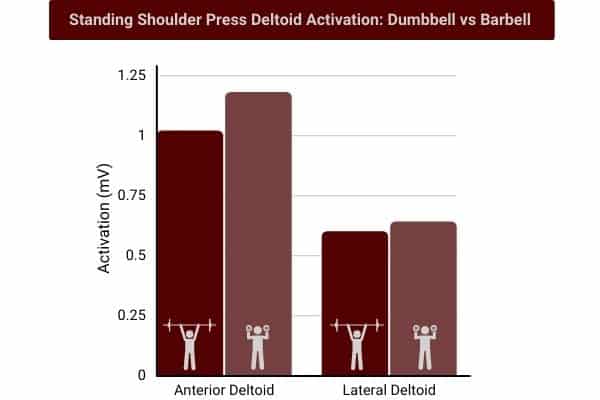
What You Need:
- Dumbbells-only.
The standing dumbbell overhead press is an effective dumbbell exercise to develop broader shoulders. It primarily activates the anterior, lateral, and posterior deltoids. But also engages the triceps and upper pecs to stabilise the movement. This increases upper body pushing power, which also benefits exercises such as the bench press.
4. Dumbbell Lateral Raise.
What I Say:
The shoulders are one of the more difficult upper body muscle groups to develop. This makes deltoid isolation exercises perfect for hardgainers to grow broader shoulders.
The lateral raise is a deltoid isolation exercise that primarily activates the anterior, lateral, and posterior deltoids. Although the trapezius is also activated as a stabilizer.
This is an effective exercise for hardgainers to target the lateral deltoids in particular, which are difficult to isolate otherwise.
Though effective, this exercise is hard!
So start with a light weight and focus on overloading with more weight or reps, slowly (but steadily) each week.
Adjustable dumbbells with small weight increments like the Powerblock Elites are perfect for this.
What The Experts Say:
Mike Dewar at Barbend explains the lateral raise is the perfect dumbbell exercise to focus your training directly onto the shoulders.
He explains that strength deficiencies in smaller muscle groups such as the deltoids can often be hidden by the larger neighboring muscles like the upper pecs.
Furthermore, these deficiencies will also limit your capabilities to grow bigger shoulders.
By performing the lateral raise, you can specifically target the deltoids for growth.
What You Need:
- Dumbbells-only.
The dumbbell lateral raise is an important accessory exercise to develop bigger shoulders. It will specifically engage the anterior, lateral, and posterior deltoids. Strength deficiencies in these smaller muscles are often hidden by larger, neighbouring muscles. This makes it important to isolate the deltoids with the lateral raise.
5. Dumbbell Overhead Tricep Extension.
What I Say:
The triceps comprise almost two-thirds of the upper arm muscle mass. And this makes it important for hardgainers who want larger arms, to find exercises that work the triceps.
Many of the other upper body pushing exercises (such as the bench press and overhead press) also engage the triceps as secondary movers.
But if you want to specifically engage the triceps, you should perform dumbbell tricep-isolation exercises such as the overhead tricep extension.
You can check out my other article to find out what a good weight is for the tricep extension.
What The Experts Say:
Josh and Kyle from Colossus Fitness explain that many people incorrectly perform the overhead tricep extension, flaring their elbows outwards.
If you do this, you are not isolating the tension onto the triceps. And as a result, your triceps will not gain significant improvements in size and definition.
Instead, Josh and Kyle recommend you tuck the elbows towards to head. And this will maximize tricep engagement.
What You Need:
- Dumbbells-only.
The overhead dumbbell tricep extension is a isolation-type exercise which can be used to specifically work the triceps. To ensure tension is localised directly onto the triceps, you should keep your elbows tucked towards the head, instead of flaring them outwards.
6. Dumbbell Bicep Curl.
What I Say:
The bicep curl is an excellent complementary exercise to pair with the tricep extension.
Together, they will hit ALL the muscles in your upper arm.
I would advise you to perform them at the END of your dumbbell workout though.
That’s because many of the other dumbbell compound pulling exercises (such as the row and the pull-up) also engage the biceps as a secondary mover.
You should work your biceps to fatigue. But not at the expense of compromising your compound pulling exercises (which are big muscle-builders).
You can check out my other article to find out how heavy your dumbbells should be for bicep curls.
What The Experts Say:
Anthony Yeung (CSCS Coach at Mens Journal) recommends you include a variety of dumbbell curls:
- Classic underhand-grip curl.
- Reverse-grip curl.
- Hammer curl.
- Concentration curl.
By varying the grip, you will target the different muscles in the biceps (including the biceps brachii, brachialis, and brachioradialis).
What You Need:
- Dumbbells-only.
The dumbbell curl is an effective exercise which targets the biceps. To gain maximum benefits from dumbbells curls you should include variations such as the reverse-grip, hammer-grip, and concentration-grip. By altering the grip and workout angle, you will engage the biceps brachii, brachiallis, and brachioradialis.
7. Bent-Over Dumbbell Row.
What I Say:
This is one of my favorite compound pulling exercises, and I highly recommend you to include them in your hardgainer training program.
The dumbbell bent-over row is a powerful exercise that will hit all the muscles in your back, as well as the biceps.
By altering your grip-width, you will ensure all the individual muscles in the back are engaged.
I recommend you to switch your grip every 2 weeks. For example, use a narrow overhand grip in your first two weeks. Then switch to a wide-overhand grip in the following two weeks.
Doing so will keep introducing variety in your training. And this is a great way for hardgainers to build a killer back!
You can check out my other article to see how heavy your dumbbells should be for rows.
What The Experts Say:
Stuart Carter (Personal Trainer at Fit Father Project) notes that the dumbbell bent-over row is a great exercise for building a thicker back, rather than a wider back.
That’s because the dumbbell bent-over row emphasizes contraction in the trapezius and rhomboids, which are located in the middle of the back.
What You Need:
- Dumbbells-only.
The dumbbell bent-over row is a compound pulling exercise which activates the trapezius, rhomboids, latissimus dorsi, and biceps. It is a great exercise to develop a thicker back. To maximise back muscle hypertrophy, you should change your grip on a biweekly basis to introduce variety.
8. Dumbbell-Weighted Pull-Up.
What I Say:
The pull-up can often be neglected by hardgainers. Mainly because it’s so hard to do!
But trust me, you should practice until you are able to complete bodyweight pull-up repetitions.
And when you are able to do 3 sets of 10 bodyweight pull-ups, you can hold a 5lb dumbbell between your legs and decrease the reps as necessary.
The dumbbell-weighted pull up is the best exercise to develop your latissimus dorsi (lats), as well as your other back muscles.
And by the time you start adding weights to your pull up, you will find your back to have developed a wide flare!
You can go to my other article to find out how much weight to add to your pull ups.
What The Experts Say:
Liam Rodgers (Fitness Writer and Weightlifter at Pullup Mate) explains that adding a dumbbell to your pull up will provide greater mechanical tension to your back muscles.
When you do this, the new stimulus will encourage your muscles to grow in strength and size!
What You Need:
- Dumbbells.
- Pull up bar.
The dumbbell-weighted-pull up is a powerful compound pulling exercise which engages the trapezius, rhomboids, latissimus dorsi, and biceps. Developing the latissimus dorsi in particular, will result in a wider back.
You may also be interested in checking out my other article for a V-shaped body workout with dumbbells.
9. Dumbbell Crunch.
What I Say:
There can be a limited range of abdominal exercises if you don’t have access to cable machines.
But the dumbbell crunch is a great dumbbell exercise to add mass and definition to your abs.
You can perform the traditional crunch to target the mid-abs. Or you can include a twisting motion at the end to engage the obliques, which are found to the side of the abdominals.
Either way, by holding a dumbbell whilst performing the exercise, you will provide the resistance required to stimulate muscle growth in the abs!
What The Experts Say:
Jim Stoppani PhD (Health and Nutrition Consultant at Jim Stoppani) recommends holding the dumbbell directly over the head, with your arms fully extended. Then contract your abs to lift your shoulders off the ground. Doing this will directly target the abdominal muscles!
What You Need:
- Dumbbells-only.
The dumbbell crunch is a great way to add mass and definition to your abdominals. The traditional crunch engages the mid abdominals, but you can also hold a dumbbell above the head whilst performing the crunch. This will provide the mechanical tension required to stimulate muscle growth.
You may also be interested in my other article to learn what muscles give you the V-cut look.
10. Dumbbell Leg Raise.
What I Say:
The lower abdominals are notoriously hard to develop, especially for hardgainers!
I recommend performing dumbbell leg raises to directly target the lower abs.
You will want to start by using your body weight first. And once you have mastered this, you can hold a 5lb dumbbell between your legs as you perform the leg raise.
Tip: it’s much easier to do this on a power tower than hanging off a pull up bar!
What The Experts Say:
Jeff Cavaliere (CSCS Coach at Athlean-X) advises you to flex the spine at the pelvis and to raise the feet to head level, before lowering them. This is the best way to engage the lower abdominals (rather than the hip flexors).
What You Need:
- Dumbbells.
- Power tower.
The leg raise is an isolation-type exercise which is great for targeting the lower abdominals. By adding a dumbbell to the exercise, you create a greater mechanical tension required to drive muscle growth. You can also incorporate a twist as you raise your legs, and this emphasises the external obliques.
11. Dumbbell Lunge.
What I Say:
The dumbbell lunge is an awesome compound leg exercise that engages all the muscles in the leg. But the emphasis is placed on the quadriceps and hamstrings.
I would recommend hardgainers to include intense leg workouts in your training program.
Not only will you see balanced upper/lower body development, but this 2014 study shows a weight training-induced hormonal response. And this response correlates with muscle size.
In other words, the bigger the muscle, the bigger the muscle-building hormone release.
And the leg muscles are some of the largest in your body!
What The Experts Say:
Mike Dewar at Barbend notes the unilateral (one-sided) nature of the lunge is a great way to correct muscle imbalances in the leg, and this will improve leg strength in bilateral exercises such as the squat.
He also recommends the lunge to be a great exercise to develop muscle size in the legs!
What You Need:
- Dumbbells-only.
The dumbbell lunge is a great unilateral exercise to increase muscle size and strength in the lower body. The lunge movement is also a compound exercise which will engage all the muscles in the leg, including the quadriceps, hamstrings, gluteus maximus, and gastrocnemius.
12. Goblet Squat.
What I Say:
All hardgainers should concentrate on leg-work to develop overall body musculature. This is because of the muscle-building hormone response described above.
The goblet squat is one of the major dumbbell exercises you can perform to target the legs.
I would recommend you tuck your elbows into your body as you hold the dumbbell. This reduces the amount of fatigue in your arms and shoulders as you perform the squat.
As a result, you will be able to work your legs harder!
You can go to my other article to find out what weight your dumbbells should be for goblet squats.
What The Experts Say:
Avi Silverberg (Powerlifter Coach at Powerlifting Technique) advises you to perform the goblet squat in a slow and controlled manner.
That’s because a goblet squat is often limited by the weight of the dumbbell (which usually has a maximum capacity of around 110lbs).
So to ensure a high intensity (despite a limited weight), perform the movement slowly.
What You Need:
- Dumbbells-only.
The goblet squat is a a dumbbell-variation of the barbell squat, a compound exercise which engages the quadriceps, hamstrings, gluteus maximus, and gastrocnemius. The goblet squat should be performed with the elbows tucked into the body to reduce fatigue in the arms.
Example Full-Body Hardgainer Dumbbell Workout.
Now, I will put the 12 exercises together.
Here is an example of a full-body hardgainer dumbbell workout:
| Dumbbell Exercise | Sets | Reps | Weight | Rest Between Sets |
|---|---|---|---|---|
| Bench Press Or Chest Fly | 3 | 9 | 70% Of 1RM | 2 Min |
| Lunge Or Goblet Squat | 3 | 9 | 75% Of 1RM. | 2 Min |
| Bodyweight/Dumbbell-Weighted Pull Up Or Dumbbell Row | 3 | 9 | 75% Of 1RM | 2 Min |
| Shoulder Press Or Lateral Raise | 3 | 9 | 75% Of 1RM | 2 Min |
| Bicep Curls Or Tricep Extension | 3 | 9 | 75% Of 1RM | 2 Min |
| Weighted Crunch Or Leg Raise | 3 | 9 | 75% Of 1RM | 2 Min |
This workout will take around 1 hour to complete.
For each workout, choose 1 exercise from each section. Then in the next week, you should perform the exercise you didn’t perform the previous week.
If you are a hardgainer who has just begun lifting weights then aim to complete 3 workouts a week. But ideally, you should progress to 4, then 5, workouts per week (when you feel ready to do so).
Notes:
- Follow the exercise order- it has been designed to allow similar muscle groups to recover before being hit again.
- Vary your angles- for the bench press and fly. For example, if you perform a flat bench press one week, then do an incline bench press the next. If you do an incline chest fly one week, then do a flat chest fly the next.
- Overload when ready- by increasing weight, decreasing rest times to 1 min, and increasing number of training days. But focus on one area to overload at a time.
- Perform dumbbell-weighted pull ups after you have mastered bodyweight pull ups- after being able to perform around 10 repetitions of bodyweight pull ups, you can add a dumbbell.
- Choose either bicep curls or tricep extension per workout- the other compound exercises will hit your biceps and triceps already.
- 1RM = 1 rep max
For a full explanation of how to properly overload, you can check out my other article for ways to increase dumbbell weight.
Recommended Gear
Here’s a full recap of the gear recommended in this article. I used these myself to build muscle at home as a hardgainer:
| Equipment | Reason |
|---|---|
| Powerblock Elite Dumbbells | Fully adjustable with heavy settings, light settings, and increments in between. |
| Flybird Weight Bench | Fully adjustable with flat, incline, and decline settings to hit all regions of your chest, back, and abs. |
| Sports Royal Power Tower | Pull-ups are one of the best exercises for a wider and thicker back. |
Conclusion
That’s it!
Today, I have shared with you a hardgainer dumbbell workout, incorporating 12 of the best muscle-building dumbbell exercises.
Combined, these 12 dumbbell exercises will work the entire body, and are exercises that have personally helped me to gain 40lbs of lean muscle (as a hardgainer!).
Having an exercise list isn’t enough though. You will need to perform your training program consistently and regularly. Additionally, you will have to overload in order to see continued muscle gains.
Which of these dumbbell exercises are you most looking forward to trying?
Let me know in the comments below!
Alternatively, download the FREE Kalibre Muscle Blueprint PDF to find out EXACTLY what it takes to transform a skinny body!
Thanks for reading guys!
Peace Out,
Kal
(Biochemistry BSc, Biomedical Sciences MSc, Ex-Skinny Guy)


